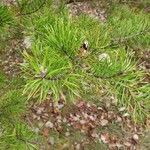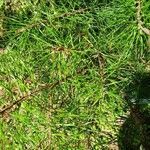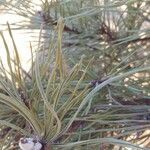Trees to 20 m tall; trunk to 0.5 m d.b.h. in native range; bark gray-brown, with irregular, scaly, plated ridges, reddish and scaly toward apex of trunk; crown irregularly rounded or flattened; branchlets red or purple tinged, often glaucous, aging red-brown or gray, slender, rough; winter buds red-brown, ovoid or cylindric, resinous or not, scales white fringed at margin. Needles 2 per bundle, deep to pale yellow-green, strongly twisted, 2-8 cm × 1-1.5 mm, stomatal lines present on all surfaces, inconspicuous, base with persistent sheath 4-10 mm, margin serrulate. Seed cones subsessile or shortly pedunculate (peduncle to 1 cm), dull red-brown, ovoid when open, symmetric, 3-7(-8) cm, maturing in 2 years, then soon shedding seeds. Seed scales with strong purple-red or purple-brown border adaxially distally, rigid; apophyses slightly elongated and thickened; umbo low pyramidal, with a slender, stiff prickle. Seeds pale brown, mottled darker, compressed obovoid, 4-7 mm, apex oblique; wing to 2 cm, narrow.
Small tree, to 10 m, or seldom to 30 m, with long, horizontal branches; bark becoming dark red-brown; twigs purplish-brown to purplish-gray; winter buds less than 1 cm, very resinous, pale cinnamon-brown; lvs in 2’s, persistent 3–4 years, dark green, soft and flexible, 4–8 cm × ca 1 mm; cones dark red-brown, oblong-conic, 4–7 cm, opening at maturity but persisting for several years; apophysis elevated, the umbo strongly raised, with a straight, slender spine 1–3 mm; seeds 1.5–2 cm. Dry, sandy or sterile soil; s. N.Y. to s. Ind., s. to Ga., Ala., and ne. Miss.
A tree up to 20 m tall. The trunk is 50 cm across. The bark is grey brown. It becomes scaly and has plated layers. The crown can be rounded or flattened. The young branches have red or purple tinges. There are 2 needles per bundle. They are deep to pale yellow-green. They are strongly twisted. They are 2-8 cm long by 1-1.5 mm wide. The seed cones have short stalks. They are oval when open and dull red brown. Seeds are pale brown and with darker mottles. They are 4-7 mm across.




